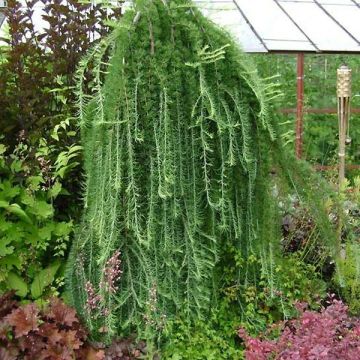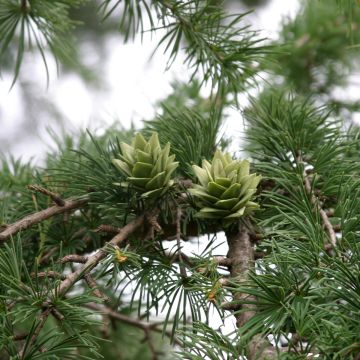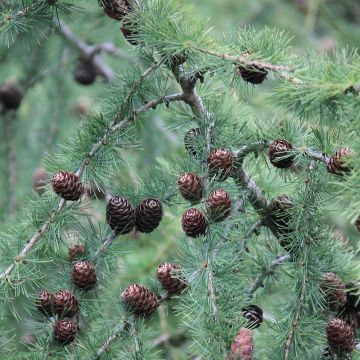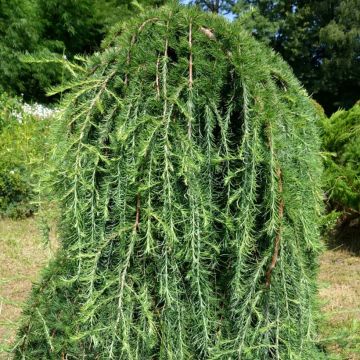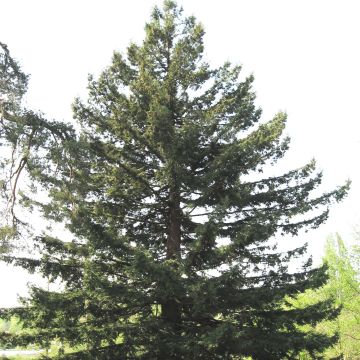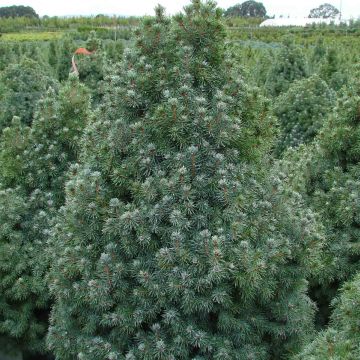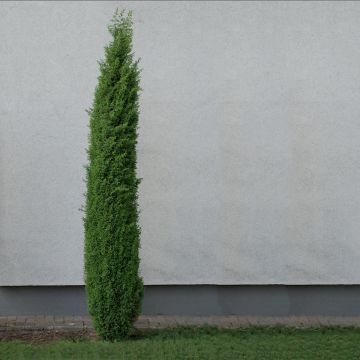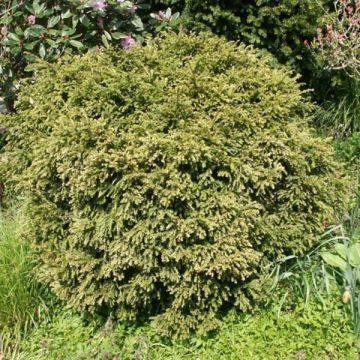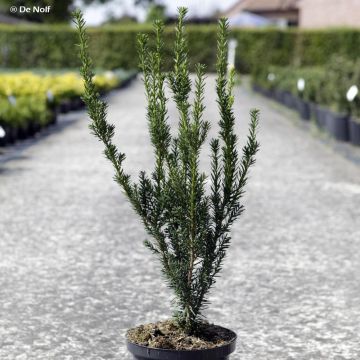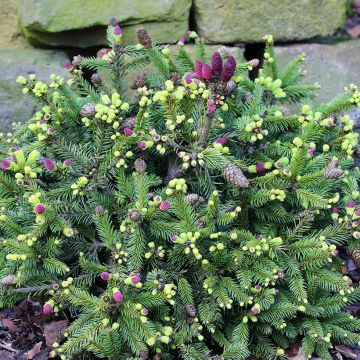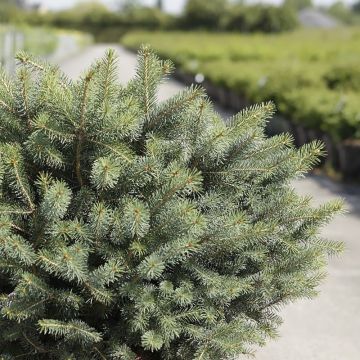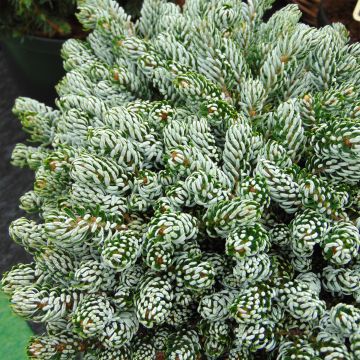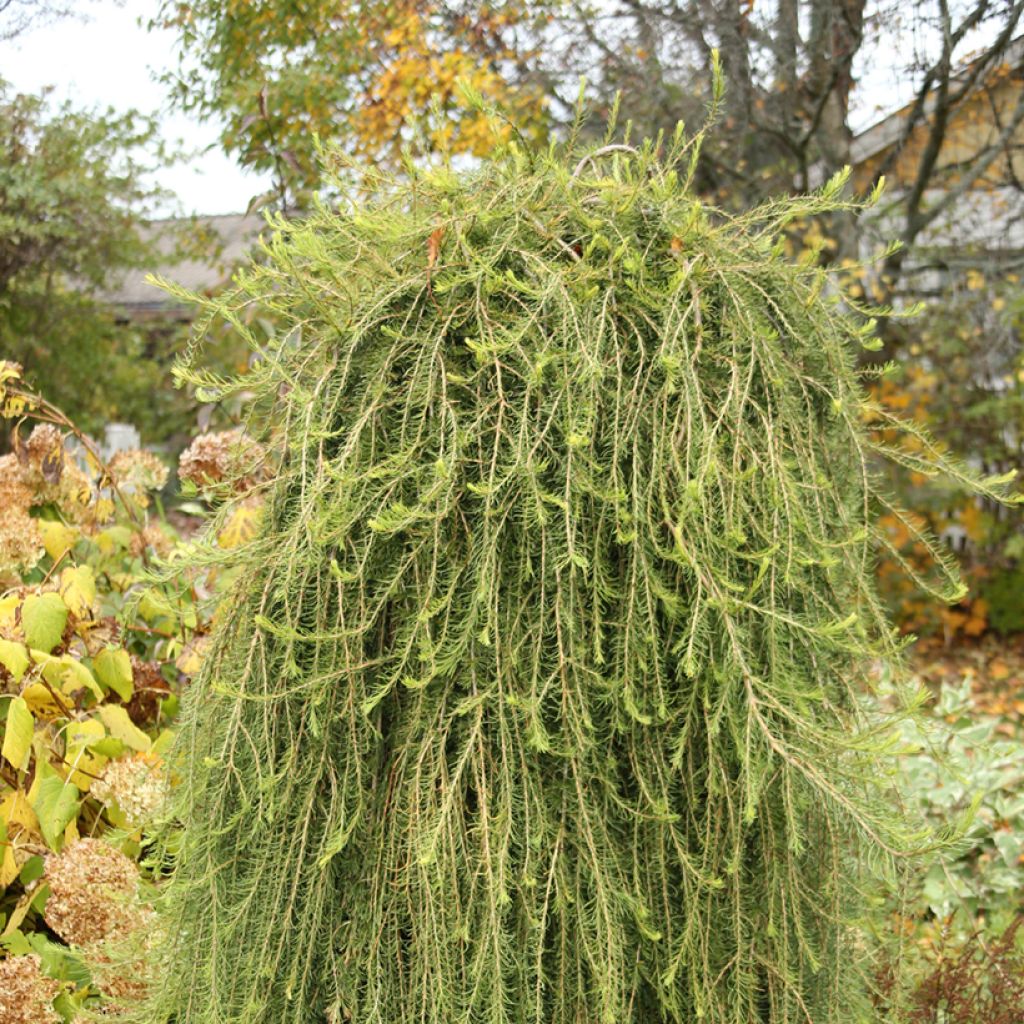

Larix decidua Puli - European Larch
Larix decidua Puli - European Larch
Larix decidua Puli
European Larch, Common Larch, Larix
This item cannot be shipped to the selected country
Oversize package delivery charge from €6.90
More information
Schedule delivery date,
and select date in basket
This plant carries a 24 months recovery warranty
More information
We guarantee the quality of our plants for a full growing cycle, and will replace at our expense any plant that fails to recover under normal climatic and planting conditions.
Oversize package: home delivery by special carrier from €6.90 per order..
Express home delivery from €8.90.
Does this plant fit my garden?
Set up your Plantfit profile →
Description
The Larix decidua 'Puli' is a narrow, weeping variety with highly pendulous branches. It is narrower than the 'Pendula' form and has a lighter shade of tender green foliage. This deciduous conifer is covered in short, tender green needles in spring, which darken as the season progresses. In autumn, the foliage takes on a lovely yellow hue before falling to the ground. This variety, originating from mountainous regions, is very hardy and prefers a light, slightly moist soil with little to no limestone, even if poor, as well as a sunny exposure.
The European Larch, Larix decidua, is a tall tree that can reach a height of 30 m, belonging to the Pinaceae family, like Firs, Spruces, Cedars, and Pines. It is one of the few conifers, along with the Bald Cypress (Taxodium) and the Dawn Redwood (Metasequoia), whose deciduous foliage falls in autumn. It is native to the mountains of central and Southern Europe, where it is found at altitudes between 1400 and 2400 m. It is a pioneering species capable of improving poor or degraded soils, with great hardiness (down to -40 °C). Highly valued for its wood, it adapts very well to lowland cultivation.
The Larix decidua 'Puli' is quite different from the original botanical species. This compact variety has a very pronounced weeping habit with a narrow silhouette. At maturity, it reaches 3 m in height and 1.30 m in width. Its long, ramified branches hang down to the ground, offering a regular habit. In spring, the branches are adorned with bright green, tender needle-like foliage, arranged in dense rosettes. The foliage darkens slightly throughout the growing season, and finally takes on beautiful yellow colours in autumn.
Extremely cold-resistant, this miniature conifer is sensitive to drought. Perfectly adapted to mountainous regions, it is not suitable for much drier southern areas. Therefore, it should be planted in a fresh, well-drained soil, exposed to the sun or possibly in light shade. Once these basic requirements are met, it proves to be quite easy to grow, requiring virtually no maintenance, except for some light pruning to control its habit.
This Larix decidua 'Puli', with its beautiful narrow and graphic silhouette, is a conifer that combines elegance with low demands, making it perfect for small gardens or as a central piece in a Japanese or exotic-inspired bed. Its narrow habit is ideal for enhancing an entrance. It is also easy to grow in a large pot, beautifying terraces and balconies. This conifer harmonises perfectly with other conifers with bushy or spreading forms. In the design of a contemporary garden, conifers enrich the space with their graphic qualities, emphasising the aesthetics of shapes, silhouettes, and textures rather than seasonal flowering changes. They provide structure to a bed in a lasting way, delimit pathways, adorn the surroundings of a terrace, and can replace trimmed boxwood thanks to their strong presence. When combined with wild grasses and heathers, they create a fascinating play of volumes and colours, offering a complementary range of temperaments.
Report an error about the product description
Plant habit
Flowering
Foliage
Botanical data
Larix
decidua
Puli
Pinaceae
European Larch, Common Larch, Larix
Cultivar or hybrid
Other Larix - Larch
Planting and care
The Larix decidua Puli is a bush plant that thrives in montane climates and is sensitive to arid conditions. It should be planted in well-drained soil in the spring or from September to November, preferably in a slightly acidic, low-limestone, sunny or semi-shaded location. A mixture of coarse sand, heather soil, and compost added to the garden soil will work well, in a planting hole with sides and depth of 50 cm. Soak the root ball in a bucket of water for fifteen minutes before planting, then water thoroughly once the hole is filled. If your soil is too heavy, a helpful tip is to plant your bush on a mound and mulch it with non-limestone gravel. Water regularly during the first two years, and in case of prolonged drought. This hardy conifer also dislikes heavy, waterlogged clay soils.
Planting period
Intended location
Care
This item has not been reviewed yet - be the first to leave a review about it.
Conifers
Haven't found what you were looking for?
Hardiness is the lowest winter temperature a plant can endure without suffering serious damage or even dying. However, hardiness is affected by location (a sheltered area, such as a patio), protection (winter cover) and soil type (hardiness is improved by well-drained soil).

Photo Sharing Terms & Conditions
In order to encourage gardeners to interact and share their experiences, Promesse de fleurs offers various media enabling content to be uploaded onto its Site - in particular via the ‘Photo sharing’ module.
The User agrees to refrain from:
- Posting any content that is illegal, prejudicial, insulting, racist, inciteful to hatred, revisionist, contrary to public decency, that infringes on privacy or on the privacy rights of third parties, in particular the publicity rights of persons and goods, intellectual property rights, or the right to privacy.
- Submitting content on behalf of a third party;
- Impersonate the identity of a third party and/or publish any personal information about a third party;
In general, the User undertakes to refrain from any unethical behaviour.
All Content (in particular text, comments, files, images, photos, videos, creative works, etc.), which may be subject to property or intellectual property rights, image or other private rights, shall remain the property of the User, subject to the limited rights granted by the terms of the licence granted by Promesse de fleurs as stated below. Users are at liberty to publish or not to publish such Content on the Site, notably via the ‘Photo Sharing’ facility, and accept that this Content shall be made public and freely accessible, notably on the Internet.
Users further acknowledge, undertake to have ,and guarantee that they hold all necessary rights and permissions to publish such material on the Site, in particular with regard to the legislation in force pertaining to any privacy, property, intellectual property, image, or contractual rights, or rights of any other nature. By publishing such Content on the Site, Users acknowledge accepting full liability as publishers of the Content within the meaning of the law, and grant Promesse de fleurs, free of charge, an inclusive, worldwide licence for the said Content for the entire duration of its publication, including all reproduction, representation, up/downloading, displaying, performing, transmission, and storage rights.
Users also grant permission for their name to be linked to the Content and accept that this link may not always be made available.
By engaging in posting material, Users consent to their Content becoming automatically accessible on the Internet, in particular on other sites and/or blogs and/or web pages of the Promesse de fleurs site, including in particular social pages and the Promesse de fleurs catalogue.
Users may secure the removal of entrusted content free of charge by issuing a simple request via our contact form.
The flowering period indicated on our website applies to countries and regions located in USDA zone 8 (France, the United Kingdom, Ireland, the Netherlands, etc.)
It will vary according to where you live:
- In zones 9 to 10 (Italy, Spain, Greece, etc.), flowering will occur about 2 to 4 weeks earlier.
- In zones 6 to 7 (Germany, Poland, Slovenia, and lower mountainous regions), flowering will be delayed by 2 to 3 weeks.
- In zone 5 (Central Europe, Scandinavia), blooming will be delayed by 3 to 5 weeks.
In temperate climates, pruning of spring-flowering shrubs (forsythia, spireas, etc.) should be done just after flowering.
Pruning of summer-flowering shrubs (Indian Lilac, Perovskia, etc.) can be done in winter or spring.
In cold regions as well as with frost-sensitive plants, avoid pruning too early when severe frosts may still occur.
The planting period indicated on our website applies to countries and regions located in USDA zone 8 (France, United Kingdom, Ireland, Netherlands).
It will vary according to where you live:
- In Mediterranean zones (Marseille, Madrid, Milan, etc.), autumn and winter are the best planting periods.
- In continental zones (Strasbourg, Munich, Vienna, etc.), delay planting by 2 to 3 weeks in spring and bring it forward by 2 to 4 weeks in autumn.
- In mountainous regions (the Alps, Pyrenees, Carpathians, etc.), it is best to plant in late spring (May-June) or late summer (August-September).
The harvesting period indicated on our website applies to countries and regions in USDA zone 8 (France, England, Ireland, the Netherlands).
In colder areas (Scandinavia, Poland, Austria...) fruit and vegetable harvests are likely to be delayed by 3-4 weeks.
In warmer areas (Italy, Spain, Greece, etc.), harvesting will probably take place earlier, depending on weather conditions.
The sowing periods indicated on our website apply to countries and regions within USDA Zone 8 (France, UK, Ireland, Netherlands).
In colder areas (Scandinavia, Poland, Austria...), delay any outdoor sowing by 3-4 weeks, or sow under glass.
In warmer climes (Italy, Spain, Greece, etc.), bring outdoor sowing forward by a few weeks.

































